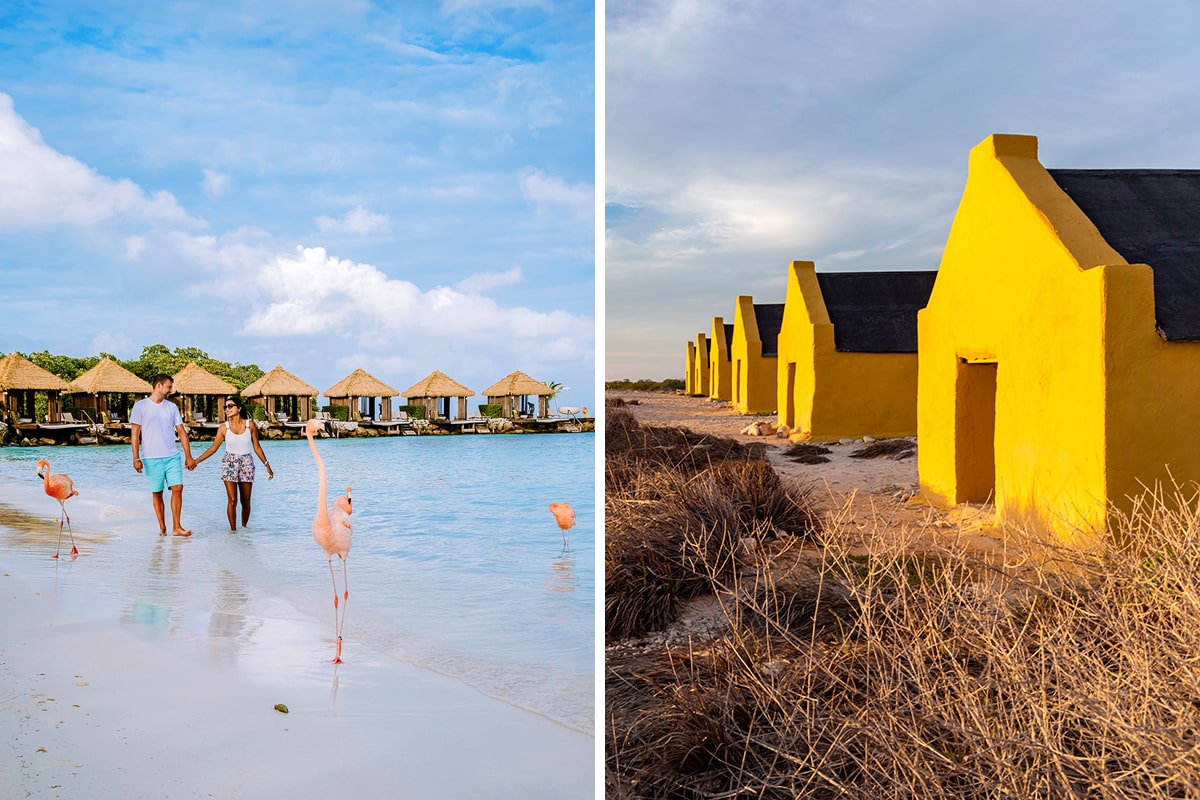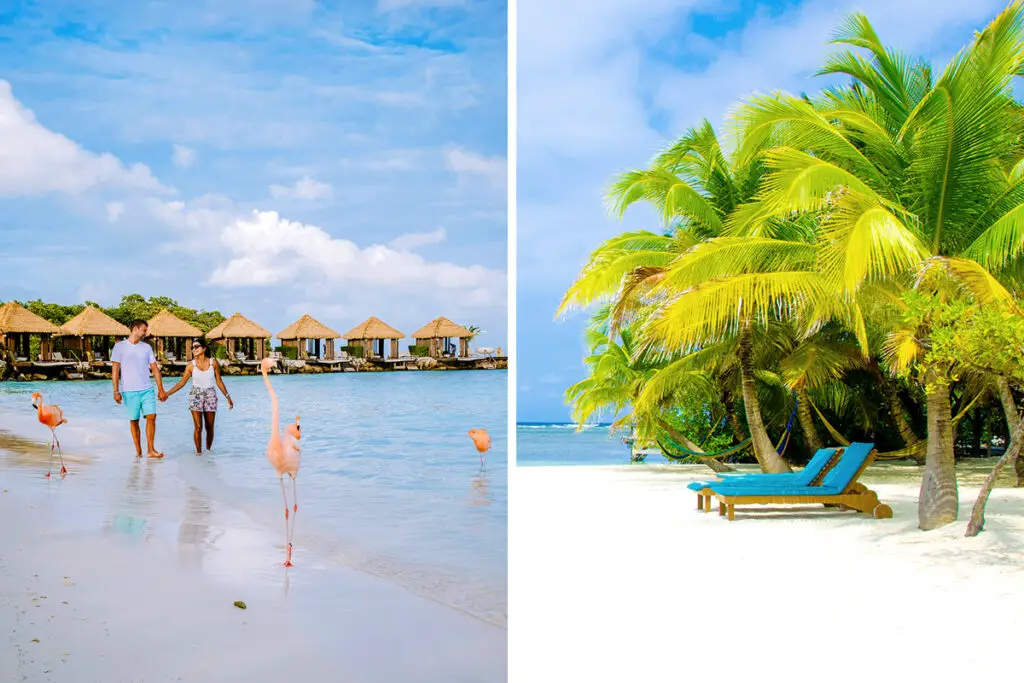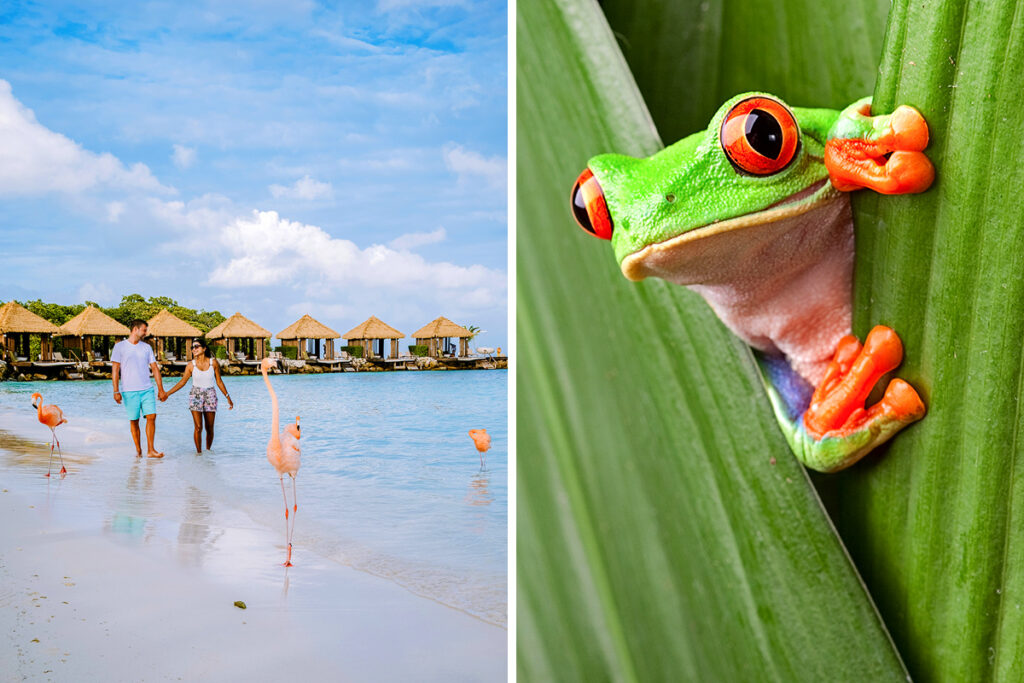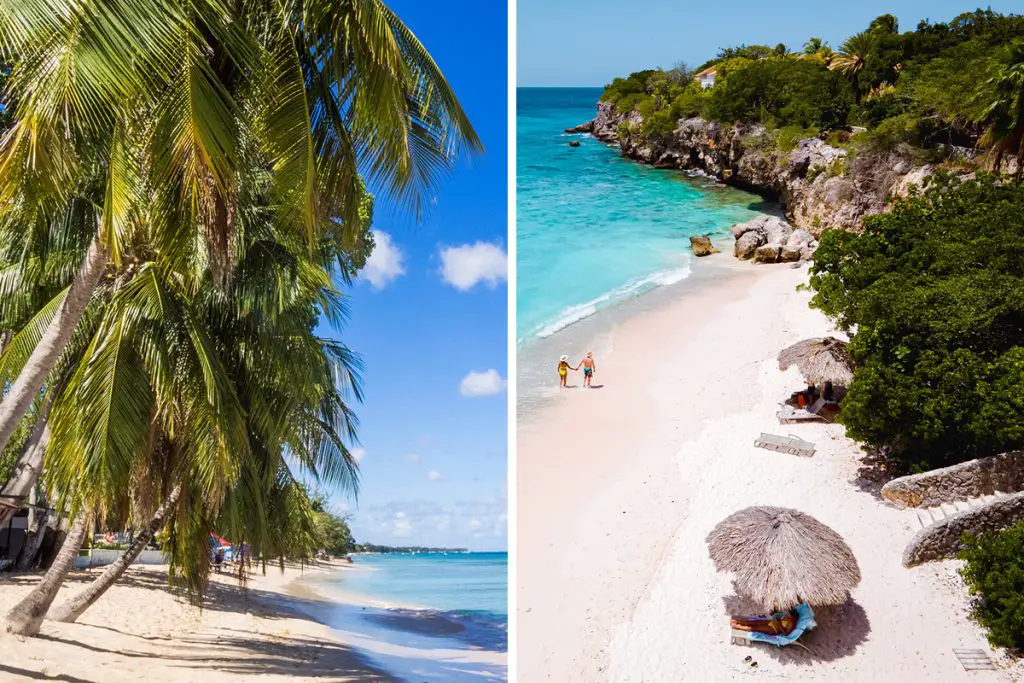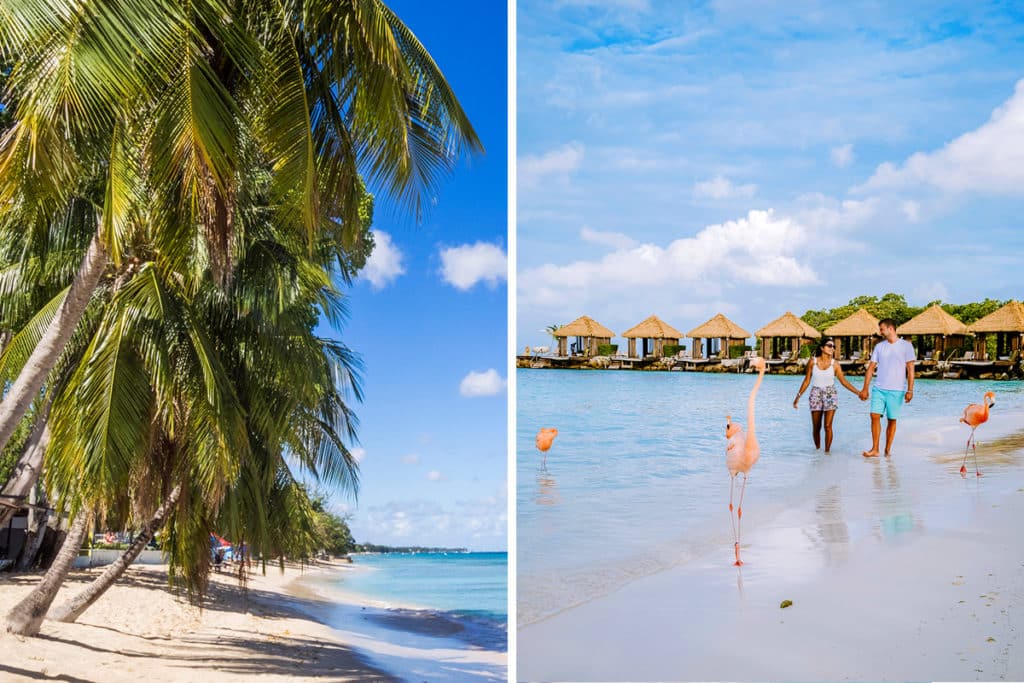Aruba
“Oruba” or “Well situated island” is but an understatement when it comes to describing what Aruba has to offer. With its considerable array of attractions condensed into one premier place, it’s one heck of a well-situated spot all right!
Swim or stroll on its picturesque beaches, some with flowing sand, some craggy. Or attempt its desert-like terrain teeming with flowering cacti interspersed among rugged rocks and ledges and the occasional beastly boulders. That is but a small section of the natural world that is Aruba.
Then there’s the colorful culture, traditions, and heritage that comes at you from the get-go. Gawk at gorgeous architecture brushed with vibrant Caribbean colors. Celebrate original only-in-Aruba festivities and their banger of a Carnival. Feast on fabulous food from eclectic multicultural cuisines. And then some.
What Makes Aruba Unique?
Sensational Shorelines
Eagle Beach always makes a splash in Aruba, it is its poster child after all. But it isn’t the only beach on the island. There are more shores along the coast that offer their own signature sensations, worthy of your attention.
Palm Beach
Two miles of beach littered with palms and palapas, a few piers and beach bars that accentuate the shore, and a thick backdrop of hifalutin high-rise hotels. This beach is filled with energy and activity, morning till night, guaranteed!
Swim or snorkel in the serene water, or bask in the sunrise and sunset quietly while sitting on the sand. And once night falls, get in the clubs and casinos for your fave pastime. Pick your poison.
Flamingo Beach
Pink plumage will meet your gaze once you step on the sandy shores of Renaissance Island’s Flamingo Beach. Flamingos are the eponymous stars of the beach, and largely, the island. Feed them with flamingo food in sort of vending machines around the island. Or take out your camera for the innumerable photo ops with them.
Even though such a number of these fine-feathered friendlies strut their stuff unfettered on the island, it is by no means a wild paradise, but rather, it is a complete-service resort with all its creature comforts, for you and the wildlife.
This beach is one of those quirky beaches in Aruba, unfortunately, not everybody can enjoy such a wonder. Plan ahead and book a night in Renaissance Island’s hotel. If you just want a day trip, stalk the hotel’s website for an opening when the hotel is not full; this is where your luck and patience come into play.
”Natural” at Its Finest
Beaches aren’t the only thing to come across in Aruba’s shores. If you have the patience and fortitude to take that first step on the off the beaten path, you are sure to be rewarded handsomely. Don’t be afraid of the trials going to these places, horseback riding and 4x4s are ready to make your trek more enjoyable.
Natural Pool
Man-made swimming pools are great and all, but natural pools? It’s a whole nother level! Inside Arikok national park you will find the most preposterous pool you will ever see.
Visualize the image of mother earth raising her cupped hands together at the border between water and land, with water spilling out from the gaps between raised fingers. Now, replace the fingers with volcanic rocks forming a sort of seawall, and the palms into a depression filled with seawater sprayed from the force of the tide on the wall.
Nothing beats the calming effect of witnessing the sights and sounds of nature doing its thing. Live on the edge of order and chaos — dive into a peaceful pool knowing full well that the turbulent tide is just on the other side.
Natural Bridge
Limestone cliffs are a sight to behold on their own, but when they have been exposed to millennia of beatdowns from wicked winds and waves, something truly magical happens and nature expresses her artistry. Aruba’s northern shores are where nature showcases her dynamic masterpieces — a veritable art gallery, if you will.
Enter Aruba’s natural bridges. They’re limestone structures whose underside has been carved out by the forces of nature to conveniently form the shape of a bridge. There are a lot of configurations to choose from — from the basic single-span bridges to the exclusive tripod bridge.
If you are the fearless kind, not afraid that at some point the bridge might collapse, take your chance at a potentially once-in-a-lifetime unique photoshoot as you never know if the bridge will still be there the next time around.
Aquatic Adventures for the Full Family
Beach bumming is pretty much the default activity when it comes to beaches and the Caribbean, but for the active and adventurous party, don’t get infected by indolent ilk or do things separately, rather, do some things that go a step further than ubiquitous water sports.
If you want a group adventure approved for your whole family here are some you should consider:
Catamaran Cruise With a Sprinkling of Snorkeling
There are a ton of tours offering a classy cruise on their catamaran. These lavish vessels are stacked with epicurean delights to give you several tanks of energy for the activities ahead, or perhaps simply relax after a meal while enjoying the view, with a cocktail in hand from a free-flowing open bar.
If your youngsters are getting restless, with nowhere to spend their energies, snorkel or swim on several sensational stops along the catamaran’s course. In the middle of nowhere (kind of), there’s a semblance of private peace, away from the throngs of tourists.
And if nothing else, pick the panoramas for your photo ops from the unique perspective of the vessel alongside the coast. Be in awe as the sun sets and the sky transitions into a star-strewn scene to wrap up a long day.
Deep Dive in a Submarine
For an out-of-this-world tour that you and your group are sure to love (except maybe for the claustrophobic folks), Aruba Atlantis Submarine Tour has got you covered. Hop aboard their US Coast Guard–approved passenger submarines ready and waiting for wide-eyed wanderers itching for a true thrill.
Explore reefs and shipwrecks without the hassle and constraints of dive gear, training, and expertise. Sit pretty inside an air-conditioned vessel, peering out of generously sized portholes into the expansive blue that is the Caribbean Sea brimming with life.
Spectacular Signature Seafood
If you go to a beach destination and you don’t savor the local signature seafood, well, you are deliberately denying yourself the full breadth of Aruban Culture if your goal is to experience it to its fullest.
Here are a few of the must-tries in virtually all online lists and, more importantly, are mainstays in restaurants faithful to the local cuisine:
Calco Stoba
Conch meat is one of the staple seafood ingredients widespread among Caribbean countries and communities. The firm white-colored meat is added to a simmer of vinegar, peppers, and classic Caribbean condiments; being careful not to overcook the meat as it is quite easy to do so.
Savor delicate conch bites washed in a savory base with a punchy aroma and kick of spice.
Pisca Hasa
Simply fried fresh fish is the name of the game when it comes to preparing the most delectable of dishes in Aruba — you need none of those fancy-pants tricks from Michelin Star chefs. All you need is a pan, some edible lubrication, and just fry the fish, marinated in salt and lime, until browned with that crispy, crunchy skin.
And of course, the secret that ties it all to Aruba is the irresistible sauce developed from heat-softened tomatoes, peppers, and select herbs and spices mixed with a blend of vinegar and tomato paste to form that rich thickness and bold color.
Sample these dishes the ideal way; in a place where you can witness the actual fish hauled in from a fresh catch and then cooked right then and there. Zeerovers Aruba is one such restaurant that provides such a service.
Bonaire
One of the three of the most coveted ABC islands of the Dutch Caribbean, Bonaire is a diver’s haven and a nomad’s paradise. When you think of Aruba, you think of upscaled delights, more cosmopolitan with an intense resort feel, but Bonaire is best reserved for the rugged wanderers, the slow budget traveler, and the laid-back beach-loving set.
Out of all the ABC Islands, Bonaire is the least visited, making it less crowded making way for a more intimate and special kind of travel. On top of its seeming seclusion, the island is blessed with unsurpassed beauty, and perfect weather that is ideal for a more laid-back getaway with friends, or a special someone. Bonaire is undoubtedly special, and criminally underrated.
What Makes Bonaire Unique?
A Scuba-Diving Haven
When you look up Bonaire, you will find that this tiny island is big on diving and a plethora of other aquatic sports. Bonaire is one of the best places to dive in the Caribbean. Scuba diving is popular on Bonaire, with over 90 locations offering challenges for divers of all levels in crystal clear water, allowing exploration of reefs, wrecks, and marine life. Many of Bonaire’s dive and snorkel locations, as well as windsurfing and other sports, provide ideal circumstances for both young and old to start the sport.
On top of a premier diving scene, Bonaire is also famous for various other watersports such as kiteboarding, windsurfing, and kitesurfing thanks to the endless trade winds blowing in from the east. You’ll be sure to have plenty of exciting things to do and around the waters of Bonaire.
Conservation Efforts
Due to the island’s “underratedness”, not a lot of people know how much of a champion of ecological conservation Bonaire is. The entire island itself is a National Park, so expect those conservation efforts wherever you go around the island heavily imposed. Since the 1960s, Bonaire has been a trailblazer in environmental conservation, beginning with the protection of its Caribbean flamingos’ breeding areas and sea turtle nesting grounds
Because Bonaire is a National Marine Park, the seas are as safe as they get. That’s wonderful news for you because it means there will be plenty of healthy coral and fauna. The Coral Restoration Foundation Bonaire has a coral reef restoration project worth seeing, but first, all divers and snorkelers must pay a Nature Fee and wear a Nature Tag at all times while in the water.
The establishment of Washington-Slagbaai Park and the Bonaire Marine Park solidified the island’s dedication to environmental management. The Bonaire Marine Park has been at the forefront of reef management and protection activities. Plus, Bonaire isn’t as heavily visited by tourists compared to Aruba and Curacao leaving most of the island unspoiled by mass tourism.
Near-Perfect Weather
Bonaire, just like the rest of the ABC islands is located far off the infamous Caribbean Hurricane Belt making the island more than ideal for a sunny getaway any time of the year. The island’s searing temperatures are often regulated by the continuous trade winds that sweep from the east, also providing perfect conditions for various watersports.
Bonaire still sees rain from time to time, especially during the summer season of June to late October. Rain during these months occurs more often but is only short and intermittent happening late in the day. But in the ABC islands, the sun is still king, you can basically visit any time of the year, depending on how you would like your travel to go.
Fewer Tourists, More Beauty
The thing with Bonaire is that it’s one of the last of its kind, and by kind meaning, lesser crowds of tourists, unspoiled nature, and great weather. The island is more of an undiscovered gem, or rather a lesser-known gem in a sea of bigger tourism players, leaving Bonaire relatively untouched by most. The tiny island is only known by tropical-loving Dutch people, and a slew of water lovers, also known as Divers and other watersport enthusiasts.
Traveling first time to Bonaire will automatically have you feel more intimate with the island as you’ll meet more locals than tourists here. Plus, with the conservation efforts of the island’s authorities who love to take to the highest levels, you’ll be met with sheer, raw, unspoiled beauty, untouched and unbothered by mass tourism. Imagine sparse crowds of tourists, the beaches all to yourselves, and all that virgin natural beauty. Bonaire is indeed something else.
Which is Better – Aruba or Bonaire?
To compare Aruba with Bonaire is like comparing two sisters on which one is better, even though both can be uber-interesting and worth it if given the chance. The undeniably irresistible Dutch sisters are some of the bests of the Caribbean, both packing some draws that are subtly different, making it even more challenging for avid travelers to decide which is which.
Aruba is best reserved for the cosmopolitan vacationer, the chic, and the travel bum, packed with draws that have perfectly balanced the charms of nature and the appeals of high street pleasures. You can have premier shopping, casino high-rolling, interesting parties at night, and all of the quirky dessert and ridiculously beautiful beaches during the day. If you want to contrast with entertaining overtones, Aruba is the best place for you.
Bonaire can be Aruba’s exact opposite, for Bonaire is rugged, rustic, and best for slow budget travelers and diving lovers. This little island packs big punches for the adventurous, the backpackers, and at the same time the chill, laid-back travelers faithfully seeking the highs of the proverbial Caribbean experience.
FAQ
Diving in Aruba vs. Bonaire
Bonaire is unquestionably the better diving location on the Caribbean’s southern coast. Bonaire is known as a diver’s paradise, with over 90 world-class dive sites suitable for all levels of diving and a range of attractions to fascinate scuba and free divers from all over the world.
Bonaire is a huge national park and reserve in itself, so you can easily imagine how big its ever-thriving diving culture is when you come. Each dive site is meticulously preserved and safeguarded to ensure that marine life thrives indefinitely. Bonaire recognizes the value of its natural beauty and strives to preserve it.
But that doesn’t mean that Aruba doesn’t have a decent diving scene, Aruba also sports interesting aquatic features. The smallest ABC Island boasts a variety of diving sites with shipwrecks as its most famous underwater feature. However, when it comes to natural beauty alone, Aruba can’t compete against Bonaire.
Bonaire vs. Aruba for Snorkeling
Because the seas of Bonaire are officially protected, you may readily witness a vast diversity of marine life, great for the ardent diver. Aruba, on the other hand, may have some valuable entries for worthy dives, however, Aruba is bigger on beaches than what’s under the waters. While it may have a variety of dive sites, the island’s best underwater feature is best reserved for scuba and free dives alike.

